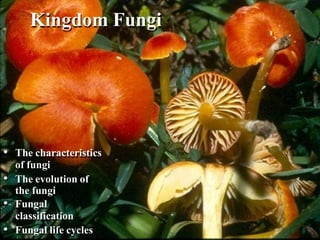
5_2018_03_05!09_27_28_AM.pptx
- 1. Kingdom Fungi • The characteristics of fungi • The evolution of the fungi • Fungal classification • Fungal life cycles
- 2. The Characteristics of Fungi • Body form * unicellular * filamentous (tube-like strands called hypha (singular) or hyphae (plural) * mycelium = aggregate of hyphae * sclerotium = hardened mass of mycelium that generally serves as an overwintering stage. * multicellular, such as mycelial cords, rhizomorphs, and fruit bodies (mushrooms)
- 4. The Characteristics of Fungi • Heterotrophy - 'other food' * Saprophytes or saprobes - feed on dead tissues or organic waste (decomposers) * Symbionts - mutually beneficial relationship between a fungus and another organism * Parasites - feeding on living tissue of a host. • Parasites that cause disease are called pathogens.
- 5. Heterotrophic by Absorption • Fungi get carbon from organic sources • Hyphal tips release enzymes • Enzymatic breakdown of substrate • Products diffuse back into hyphae Product diffuses back into hypha and is used Nucleus hangs back and “directs”
- 6. Hyphae • Tubular • Hard wall of chitin • Crosswalls may form compartments (± cells) • Multinucleate • Grow at tips
- 7. Fungi as Saprobes and Decomposers
- 8. Fungi as Symbionts (Mutualism)
- 9. Mycorrhizae • “Fungus roots” • Mutualism between: * Fungus (nutrient & water uptake for plant) * Plant (carbohydrate for fungus) • Several kinds * Zygomycota – hyphae invade root cells * Ascomycota & Basidiomycota – hyphae invade root but don’t penetrate cells • Extremely important ecological role of fungi
- 10. “Ecto”mycorrhizae Russula mushroom mycorrhizas on Western Hemlock root Fungal hyphae around root and between cells Mycorrhiza cross sections
- 11. Lichens • “Mutualism” between * Fungus – structure * Alga or cyanobacterium – provides food • Three main types of lichens: * Crustose lichens form flat crusty plates. * Foliose lichens are leafy in appearance, although lobed or branched structures are not true leaves. * Fruticose lichens are even more finely branched and may hang down like beards from branches or grow up from the ground like tiny shrubs.
- 12. Fungi as Parasites & Pathogens
- 13. Fungi are Spore • Spores - asexual (product of mitosis) or sexual (product of meiosis) in origin. • Purpose of Spores * Allows the fungus to move to new food source. * Resistant stage - allows fungus to survive periods of adversity. * Means of introducing new genetic combinations into a population
- 14. Reproduce by spores • Spores are reproductive cells * Sexual (meiotic in origin) * Asexual (mitotic in origin) • Formed: * Directly on hyphae * Inside sporangia * Fruiting bodies Penicillium hyphae with conidia Pilobolus sporangia Amanita fruiting body
- 15. Hyphal growth from spore germinating spore mycelium • Mycelia have a huge surface area
- 16. The Characteristics of Fungi • Fungus is often hidden from view. It grows through its food source (substratum), excretes extracellular digestive enzymes, and absorbs dissolved food. • Indeterminate clonal growth. • Vegetative phase of fungus is generally sedentary.
- 17. The Characteristics of Fungi • Cell wall present, composed of cellulose and/or chitin. • Food storage - generally in the form of lipids and glycogen. • Eukaryotes - true nucleus and other organelles present. • All fungi require water and oxygen (no obligate anaerobes). • Fungi grow in almost every habitat imaginable, as long as there is some type of organic matter present and the environment is not too extreme. • Diverse group, number of described species is somewhere between 69,000 to 100,000 (estimated 1.5 million species total).
- 19. Chytridiomycota – “chytrids” • Simple fungi • Produce motile spores - zoospores • Mostly saprobes and parasites in aquatic habitats • Could just as well be Protists Chytridium growing on spores Chytriomyces growing on pine pollen
- 20. Zygomycota – “zygote fungi” Rhizopus on strawberries • Sexual Reproduction - zygosporangia • Asexual reprod. – common (sporangia – bags of asexual spores) • Hyphae have no cross walls • Grow rapidly • Decomposers, pathogens, and some form mycorrhizal associations with plants Rhinocerebral zygomycosis
- 21. Life cycle of Rhizopus Asexual sporangium with spores inside Sexual zygsporangium with one zygospore
- 22. Ascomycota – “sac fungi” • Sexual Reproduction – asci (sing. = ascus) • Asex. Reprod. – common • Cup fungi, morels, truffles • Important plant parasites & saprobes • Yeast - Saccharomyces • Decomposers, pathogens, and found in most lichens Acluster of asci with spores inside
- 24. Basidiomycota – “club fungi” • Sexual Reproduction – basidia • Asexual reprod – not so common • Long-lived dikaryotic mycelia • Rusts & smuts –plant parasites • Mushrooms, polypores, puffballs, boletes, bird’s nest fungi • Enzymes decompose wood, leaves, and other organic materials • Decomposers, pathogens, and some form mycorrhizal associations with plants SEM of basidia and spores
- 25. Meiosis Hyphal fusion of haploid mycelia haploid mycelium Nuclear fusion in basidium young basidia - the only diploid cells mycelium and fruiting body are dikaryotic Mushroom Life Cycle N 2N N+N
- 27. Yeasts • Single celled fungi • Adapted to liquids * Plant saps * Water films * Moist animal tissues Candida Saccharomyces
- 28. Molds • Rapidly growth • Asexual spores • Many human importances * Food spoilage * Food products * Antibiotics, etc. Fig 31.21Antibiotic activity Noble Rot - Botrytis
- 29. HUMAN-FUNGUS INTERACTIONS • Beneficial Effects of Fungi * Decomposition - nutrient and carbon recycling. * Biosynthetic factories. Can be used to produce drugs, antibiotics, alcohol, acids, food (e.g., fermented products, mushrooms). * Model organisms for biochemical and genetic studies. • Harmful Effects of Fungi * Destruction of food, lumber, paper, and cloth. * Animal and human diseases, including allergies. * Toxins produced by poisonous mushrooms and within food (e.g., grain, cheese). * Plant diseases.